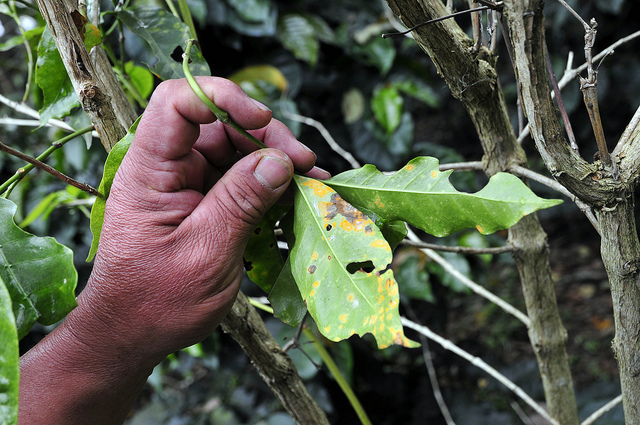by Michael Sheridan of CRS Coffeelands Blog
The first day of the First International Coffee Rust Summit is in the books. Here are some of the quotes and notes that stood out most for me from the first full day of proceedings:
EXECUTIVES’ SUMMARIES
How the executive directors of some of the world’s leading coffee organizations framed the event.
- “This is not a typical conference where you come to sit and learn. It is much more oriented toward finding solutions.” – Tim Schilling, Executive Director, World Coffee Research
- “We have the resources, knowledge and will to control coffee rust.” – Elsa Murano, Executive Director, Norman Borlaug Institute for International Agriculture
- “Lasting solutions will require collaboration between public and private sector actors all along the coffee chain…The private sector is not capable of addressing this crisis alone. And governments can’t do it alone in a world that is ever more complex and specialized.” – Roberio Oliveira Silva, Executive Director, International Coffee Organization
- “This kind of event represents the best hope we have to address not just coffee rust but all the shared challenges we face.” – Ric Rhinehart, Executive Director, Specialty Coffee Association of America
- “We are anxious to work with coffee farmers as partners in a common cause: protecting the well-being of the Central American coffee community.” – Robert Nelson, President and CEO, National Coffee Association
- “Coffee rust is a symptom of the problems our coffee sectors face in the region.” – Armando García, Executive Secretary, PROMECAFE
THE IMPACTS
- 2.3 million 60-kilo sacks in lost production
- $550 million in lost farmer income
- 500,000 jobs lost
– source: PROMECAFE
UNDERLYING PROBLEMS
Aging coffee plantations
- 60 percent of the coffee in Honduras is older than 20 years. (IHCAFE Executive Director Víctor Hugo Molina)
- 30-40 percent of the coffee in Costa Rica is older than 30 years (ICAFE Executive Director Ronald Peters)
- We have coffee that is 80 years old. (CODOCAFE Executive Director José Núñez; He later told me that he is 53 years old. He started working on his grandfather’s coffee farm when he was 7 or 8 years old, and his family is still farming the coffee he harvested as a boy.)
Limited institutional capacity.
- Honduras’ coffee institute has 120 coffee agronomists.
- Guatemala’s has 117.
THE SCIENTISTS
- “An epidemic is a race between a plant and a pathogen.”
- “Climate change was the detonator.”
- “Shade coffee resisted rust more effectively than sun-grown coffee.”
- “Now is the time to renovate.”
— Jacques Avelino, Coffee Rust Pathologist, CIRAD-CATIE
- “Many people said there was not enough warning. There was some warning. It started in 2010.”
- “All non-resistant varieties were affected, including Catimor. Could we be seeing breakdown of resistance? It does happen.”
- ”In summary — it’s complicated.”
– Peter Baker, Coffee Agronomist, CABI
ON MANAGING COFFEE RUST
Using resistant varieties
- “We do not think moving to resistant varieties is the only answer.”
– Anacafé
Organically
- “I don’t know how organic coffee can have a future. There is nothing that works to control rust in the field and I am not seeing anyone in the market offering more to create additional incentives for organic farmers.”
– Miguel Medina, Anacafé
Conventionally
- ”Fungicides are like a car. If you drive a car at 50km an hour, it is safe. If you drive at 200 km, it is not.”
– Marco Dutra, Syngenta
Michael Sheridan
Michael Sheridan is the Chief Executive Officer of the Coffee Quality Institute, a nonprofit organization with a mission to improve coffee quality and the lives of those who produce it. Sheridan has been leveraging market forces to make coffee work for smallholder farmers and farm workers since 2004. Most recently he directed progressive green coffee sourcing activities and direct-trade partnerships at Intelligentsia Coffee. Prior to that he worked to deliver initiatives in the coffee sector in Central and South America on behalf of Catholic Relief Services.







Comment